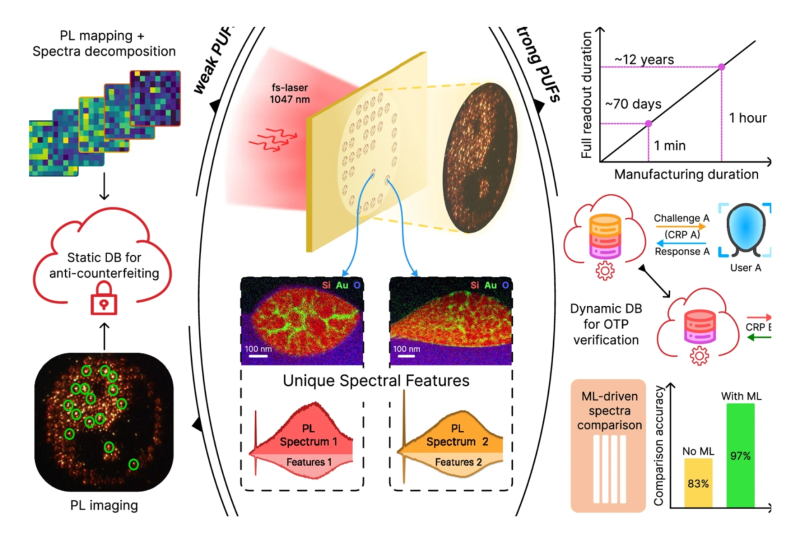Scientists at ITMO have come up with a new way to protect microelectronics devices from counterfeit. The new technology is based on gold and silicon nanoparticles with unique optical properties that make it possible to create unclonable functions with a record information density. Such functions can also be used for generating cryptographic keys. The results of the study were described in Nature Communications.

A visualization of the new method. Image courtesy of the researchers
Modern security tags used to protect microelectronics, banking, and luxury goods are created using holograms, watermarks, and UV ink. These tags can be easily and endlessly reproduced if the necessary tools are available, so all of them have a short lifespan, resulting in the need to use a great number of different holograms to ensure protection.
To counteract this, scientists create tags based on systems with random structural features that arise uncontrollably during their production. An example of such systems is a pattern of randomly scattered particles. The only way to counterfeit such tags is to carefully “assemble” an identical pattern by hand, for example, using a nanomanipulator.
In order to make tags even more secure, scientists strive to reduce the size of these random structural features down to the nanoscale. In other words, they are working on creating increasingly miniature patterns from particles, as well as studying particles that can have random features such as shape and internal structure. This transition to the nanoscale will make it possible to encode a greater amount of information, and thus create more substantial sources of cryptographic keys. However, such nanolabels will be difficult to read not only for criminals, but also for scientists, since existing optical microscopes are not powerful enough to identify such tiny patterns.

Bilayer gold-silicon films were processed with a laser to produce hybrid particles. Based on their spectral analysis, the scientists suggested two unclonable protection methods, as well as a model of an optical one-time password verification token. Credit:
A team of researchers from ITMO University, Université de Lorraine (France), and New Uzbekistan University (Uzbekistan), decided to forego the direct visual analysis of protective tags through a microscope. Instead, they suggested using photoluminescence to read the information off of a label. For this purpose, the researchers randomly applied hybrid gold-silicon nanoparticles to a substrate, exposed them to a laser, and measured their spectral characteristics. It turned out that each particle emits light with a unique spectrum determined by its internal structure. This “optical fingerprint” cannot be counterfeited: as even if one attempts to replicate the arrangement of nanoparticles, their optical properties cannot be duplicated. Essentially, the internal structure of these particles automatically encodes the spectral characteristics read during tag identification.
With the new method, it was possible to overcome the optical limitations and achieve a high density of unique information storage in the resulting tags – 930 bits per square micrometer, which is at least 2 to 3 orders of magnitude higher than in earlier studies. This approach opens up possibilities not only for counterfeit protection, but also for creating truly random cryptographic keys.
“The core of our method is in using a spectrometer to measure the signal of each individual particle and obtain unique spectra: each has a distinct shape, intensity, and other characteristics closely related to the internal structure and arrangement of the particles. Tags based on this new method can be used to protect microelectronics, as well as be applied in hardware cryptography for generating random keys. In the future, we plan to develop unclonable tags that use simpler reading methods, such as radio-frequency identification (RFID) and NFC,” shares Martin Sandomirskii, the paper’s first author and a researcher at the of ITMO’s School of Physics and Engineering. The study was conducted under the supervision of Dmitry Zuev, a researcher at the school.

Martin Sandomirskii. Photo courtesy of the subject
Additionally, in their study, the researchers suggest the concept of an optical verification token – an optical “flash drive” that can generate one-time passwords based on unique spectral characteristics. In the future, such tokens can be used in optical computers for supersecure verification systems.
